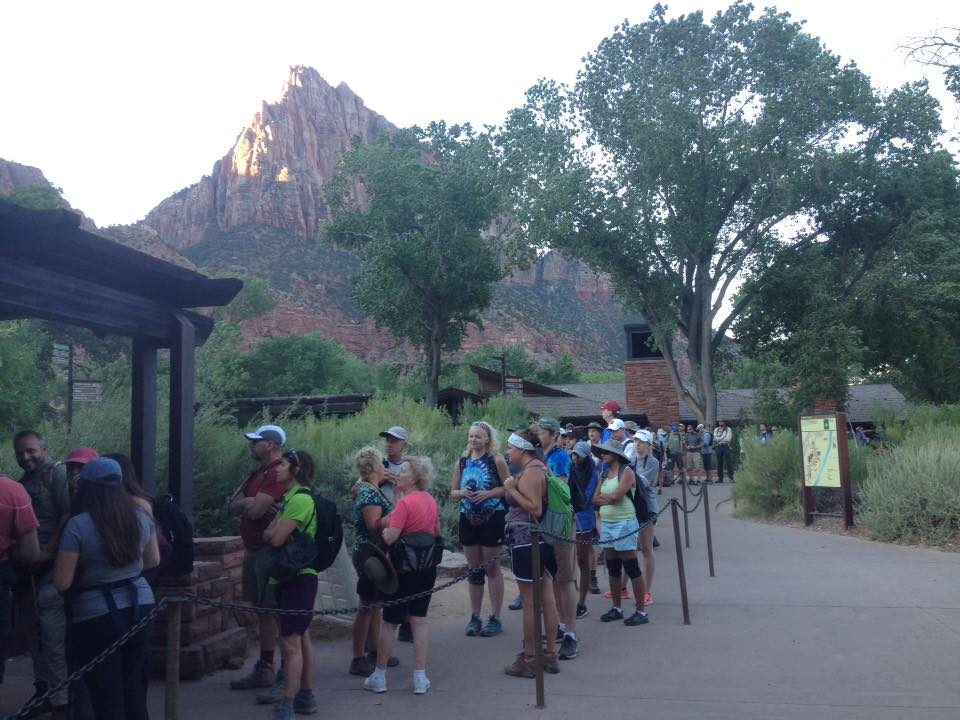
This plan serves to address several issues within Zion National Park. Right now if you visit Zion on a busy day you may have the following experience similar to that of hundreds of thousands other visitors: You wait in line 20-30 minutes at the entrance station, only to get there and be told that there is no parking inside the park. You go into the park anyways on the off chance that someone has left and circle the parking lot for 20 minutes before deciding to exit the park and take the shuttle in. Once you have found your parking spot back in Springdale, you wait at the shuttle stop for 10-15 minutes that brings you back to the park after a 15-25 minute shuttle ride. That shuttle ride is packed like it’s a New York subway during rush hour. After finally arriving to the park after all of that, you wait another 10 minutes at the pedestrian entrance (and let’s hope you didn’t forget your park pass back in your parked car in town) only to get in another line, this time for the park shuttle. That line can sometimes be up to an hour and a half long. Once you get on the shuttle, you are jam packed in, once again, like an NYC subway. It’s another 40 minute shuttle ride up the trailhead for the Narrows. As you and everyone else on the shuttle with you get off, you probably only have one thing on your mind- the bathroom. However, with everyone getting off the shuttle at once and there only being 5 stalls, you decide you don’t want to wait in one more line and hold it. However, you can only hold it so long and so somewhere along the trail you go about your business. The trail itself is so crowded that you can’t get a good picture and the entire time it smells like an outhouse from many people, just like you, who simply couldn’t hold it any longer. Once you finish your smelly hike, you wait in just of long of a line to head back out of the park as you did to head in.
The may seem like an exaggeration, but it is the reality that actual hundreds of thouNeedless to say, many of Zion’s visitors are frustrated and upset after their visit. This is a far cry from the pristine wilderness experience that people expect when coming to a national park. Too many people, not enough space, not enough parking, not enough bathrooms, not enough staff to manage it. Zion hopes to restore the visitor experience with one of the two following plans.
Alternative B
- Establish online year-round reservation system for entry into the park & for frontcountry areas.
- Reservations would need to be acquired before entering the park (Same for C)
- With a reservation visitors could go to any of the park’s frontcountry areas
- Number of reservations issued based on frontcountry visitor capacities for the park
- Number of reservations would vary by season (Same for C)
- Reservation not required for driving through park without stopping to hike or picnic, entrance fee would still be required (Same for C)
- Oversized vehicles would have set times to go through tunnel in morning and evening, otherwise tunnel would be closed to oversized vehicles
- Commercial use (e.g., hiking, biking, tour bus) would be part of the capacity determination & would also require a reservation (Same for C)
Alternative C
- Establish online year-round reservation system for entry into the park & specific sites (trails, areas) in frontcountry areas
- Visitors would only be able to visit the sites for which they have obtained a reservation
- Number of reservations issued based on frontcountry visitor capacities for specific trails/areas
- In addition to canyoneering and overnight use, all day-use hiking into wilderness would require a permit, obtained through the reservation system
- Number of reservations based on protection standards identified in Wilderness Stewardship Plan
- Oversized vehicles would not be allowed through the tunnel, would have to enter and exit through the South Entrance
These are just preliminary concepts, and they are open to public comment for two more weeks. To comment and read more information about the VUMP click here. Proposing that entrance to a national park be by reservation only is completely game changing and it will be interesting to see where this goes in future. I will definitely be following along.
